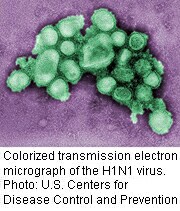
FRIDAY, Dec. 4 (HealthDay News) — The number of states reporting widespread swine flu activity continued to decline this week — to 25 from a high of 48 just two weeks ago, a U.S. health official said Friday.
Meanwhile, the supply of H1N1 swine flu vaccine continues to increase, Dr. Thomas R. Frieden, director of the U.S. Centers for Disease Control and Prevention, said during an afternoon press conference.
“As of today there are 73 million doses of H1N1 vaccine available,” he said. “That’s twice the number that were available a month ago, [and] it’s 10 million more than last week, and we expect at least another 10 million doses in the coming week.”
Children, pregnant women, young adults, health-care workers, people who take care of infants, and adults with underlying health problems such as asthma and diabetes remain at the top of the list for vaccination, Frieden said.
“We don’t know how likely a future wave of H1N1 influenza is this year, but we do know that the more people that are vaccinated, the less likely we will have more spread in the coming months,” he said.
Frieden said that all the data so far on the safety of the vaccine is “reassuring.” For instance, rates of Guillain-Barre syndrome, which apparently increased in response to the swine flu vaccine of 1976, have not changed with this year’s vaccine, he said.
“The likelihood that we will have a 1976 problem with this year’s H1N1 influenza vaccine is vanishingly remote,” he said.
Guillain-Barre syndrome is a disorder in which the body’s immune system mistakenly attacks the peripheral nervous system.
This year’s swine flu continues to target children and young adults, Frieden said. “Sadly, this week we documented an additional 17 cases of children who died from influenza. That brings the total of laboratory-confirmed deaths among children to 210,” he said.
“The number of people, not just children, but young adults under the age of 50, who will get severely ill or die from this virus is much higher than it is from seasonal flu,” he added.
It’s impossible to predict whether the H1N1 swine flu will surge again during the winter and next spring, Frieden said.
During a press conference Tuesday, he said that, of the experts polled by the agency on the odds of another surge, about 50 percent said there would be one, and about 50 percent said there would not be one — and one expert said “flip a coin.”
Frieden noted that during the flu pandemic of 1957-1958, cases surged at the start of the school year and then waned, but surged again from December to February.
More information
For more on H1N1 swine flu, visit flu.gov.

